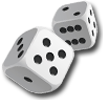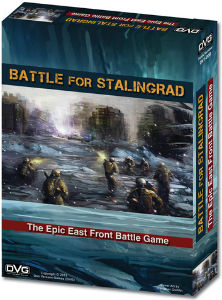



play board games
Board game reviews, strategy tips & session reports
Battle for Stalingrad Review
 Stats:
Stats:
No. of players: 2
Amount of time to play: 60-90 min
Age requirements: 12+
Set-up time: 5 min
Battle for Stalingrad is a card-based war game for two players. You must manage your resources and control all five locations to win.
Battle for Stalingrad Rules Description:
To start Battle for Stalingrad you shuffle and place five location cards in between you and your opponent. Each location has two zones, the control area and perimeter area. Each area can hold up to three force cards.
Each player has their own force deck. Force cards have a point cost, combat value and a number of starting rations. The Russian player starts by placing eleven points worth of forces on their side of the locations cards. Then the German player places nine points of force cards in the perimeter areas on their side of the locations. After placement you add ration tokens equal to a force’s starting rations value.
To win one player must control all five locations. To have control of a location you must be the only player with forces in its control area.
Players have their own deck of action cards. These are shuffled and then the Russian player draws ten cards and the German player draws five. The German player begins the game.
A player’s turn consists of three phases, supply, action and draw. During the supply phase you gain rations based on the locations you control. You must distribute rations you gain from a location to forces in that location. Also any force in your perimeter areas automatically gains one ration.
The action phase lets you play action cards, buy new forces, resupply forces, move forces or attack your opponent. Action cards are used for a few different things in the game. You may play them for their text. Each card explains when it is to be played and how it can help you or hurt your opponent. To buy new forces you must discard cards equal to the force’s cost. You may discard them to resupply rations to any forces. Each card you discard lets you place two rations on any forces.
You can move forces from your perimeter to any of your control areas or from any control area to any perimeter or uncontrolled area. When you move a force you must remove one ration from it. If you are in a control area with an opponent’s forces you may attack. This also costs one ration.
When you attack you can play action cards for their firefight value. The attacker may play or pass first and then the defender may play or pass. This continues until both players pass consecutively. Then each player flips the top card of their action deck and applies its firefight value. The firefight values are -3, -2, -1, 1, 2 and 3. Plusses add to your combat value and minuses subtract from your opponent’s combat value. To resolve combat you apply your combat value in hits to your opponent’s forces. Each hit removes one ration from a force and if a force runs out of rations it is destroyed. A force can absorb two hits by retreating to its perimeter area (if there is room).
Combat causes locations to be damaged and each time there is an attack at a location you place a rubble tile on it. This reduces the amount of rations it gives during the supply phase.
You end your turn by drawing five action cards plus one for each location you control.
The game ends once someone controls all five locations.
Quick Review of Battle of Stalingrad:
Battle for Stalingrad is a war game with a good bit resource management and some area control. You need to be able to manage you action cards and rations to outlast your opponent.
The components for the game are well made and look pretty good. The box art and some of the cards aren’t very exciting, but they do fit the theme and feel of the game. And the rules are easy to follow and teach.
I really like how everything is tied together in this game. Action cards can be used to get new forces, more rations, boosting combat values or their on-card effects. Using action cards for defense means you have less for offense. But you need to decide how best and when to use them given the current game state. Your decisions matter.
Similar to above rations are the lifeblood of your forces and you need them to move, attack and survive. How and when you spend them can be vital to your success.
Though I do like this Battle for Stalingrad’s mechanics and tight design, it feels like tug of war over the locations. Maybe it is my group’s play style but I feel like it is really tough to gain and hold control of locations. This can make the game feel like it drags a bit.
It is also good to know that the action cards have a lot of text for new players to read. It can be a little overwhelming but even halfway through the first game you have seen and read all the variations of the action cards.
Battle of Stalingrad is a fun, two-player war game that requires smart resource management and some luck to win. If you enjoy historical war games or are looking for a new two-player board game you should try this one out.
Score and synopsis: (Click here for an explanation of these review categories.)
Strategy 3 out of 6
Luck 4 out of 6
Player Interaction 5 out of 6
Replay Value 4 out of 6
Complexity 4 out of 6
Fun 4 out of 6
Overall 4 out of 6

Leave a Reply